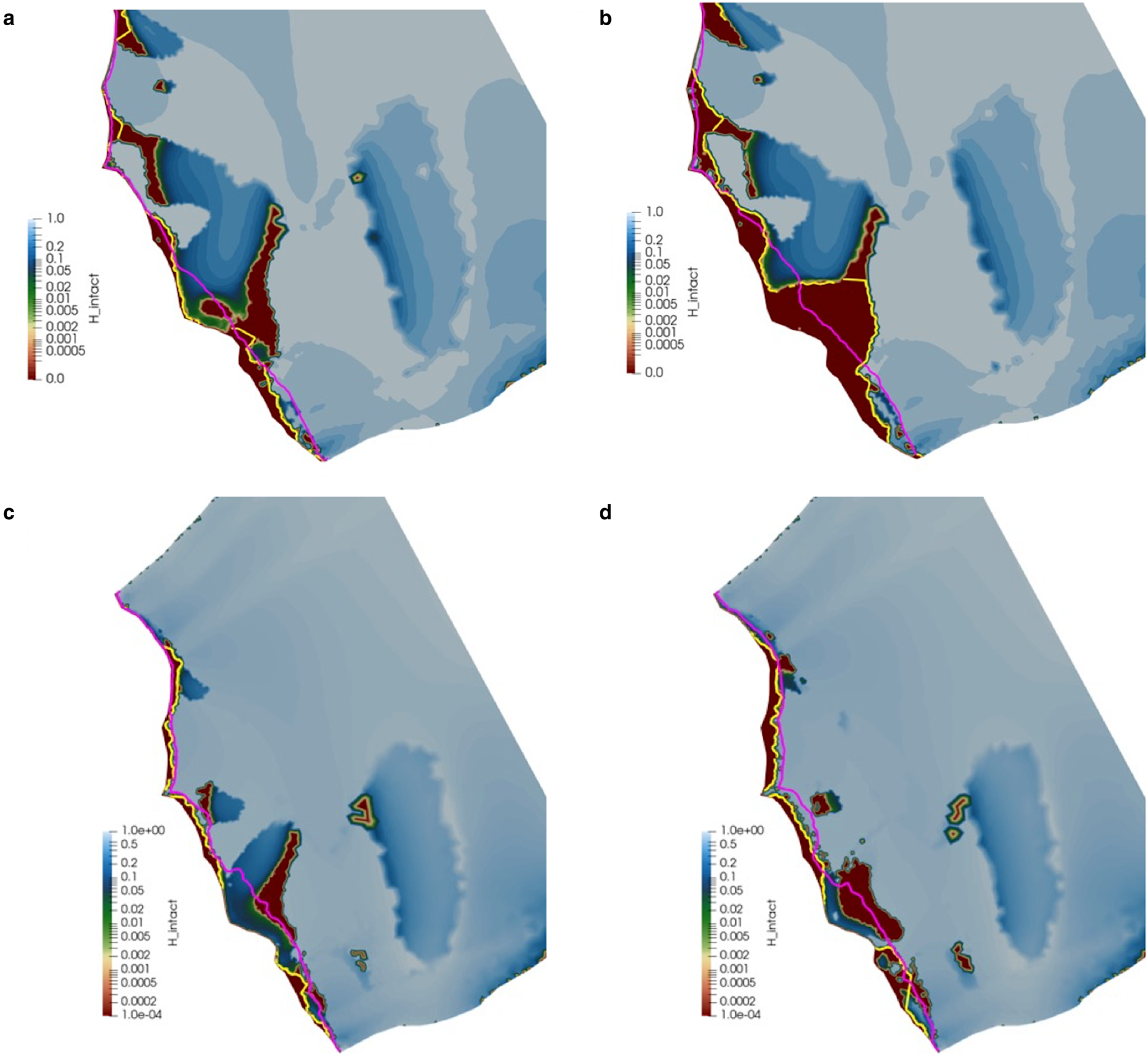A closer look on ISMIP6-Antarctica results
In this latest article on ISMIP6-Antarctica intercomparison (including contribution from Elmer/Ice), a closer look is taken on the results for high carbon emission ![]() scenarios. The work focuses on key glaciers around the Antarctic Ice Sheet in order to quantify their projected dynamic mass loss through increased ice discharge into the ocean in response to changing oceanic conditions. Particular attention is given to glaciers contributing the most to sea level rise, as well as their vulnerability to changes in oceanic conditions. These key glaciers - alongside the whole ice-sheet - in the further are investigated for the different sources of uncertainty and their relative role in projections. The findings are that in addition to the "usual suspects" in W-Antarctic ice-sheet (that be Thwaites and Pine Island) also outlet systems in E-Antarctica (Moscow University and Totten) show high sensitivity to increased oceanic ice-melt. Further, the uncertainties of the choice of climate models and the parametrization of the ocean melt have been investigated. Yet, overall, the highest uncertainty in dynamic ice-loss seems to be coming from the choice of the ice-sheet model.
scenarios. The work focuses on key glaciers around the Antarctic Ice Sheet in order to quantify their projected dynamic mass loss through increased ice discharge into the ocean in response to changing oceanic conditions. Particular attention is given to glaciers contributing the most to sea level rise, as well as their vulnerability to changes in oceanic conditions. These key glaciers - alongside the whole ice-sheet - in the further are investigated for the different sources of uncertainty and their relative role in projections. The findings are that in addition to the "usual suspects" in W-Antarctic ice-sheet (that be Thwaites and Pine Island) also outlet systems in E-Antarctica (Moscow University and Totten) show high sensitivity to increased oceanic ice-melt. Further, the uncertainties of the choice of climate models and the parametrization of the ocean melt have been investigated. Yet, overall, the highest uncertainty in dynamic ice-loss seems to be coming from the choice of the ice-sheet model.
Read more:
Seroussi, H., Verjans, V., Nowicki, S., Payne, A. J., Goelzer, H., Lipscomb, W. H., Abe-Ouchi, A., Agosta, C., Albrecht, T., Asay-Davis, X., Barthel, A., Calov, R., Cullather, R., Dumas, C., Galton-Fenzi, B. K., Gladstone, R., Golledge, N. R., Gregory, J. M., Greve, R., Hattermann, T., Hoffman, M. J., Humbert, A., Huybrechts, P., Jourdain, N. C., Kleiner, T., Larour, E., Leguy, G. R., Lowry, D. P., Little, C. M., Morlighem, M., Pattyn, F., Pelle, T., Price, S. F., Quiquet, A., Reese, R., Schlegel, N.-J., Shepherd, A., Simon, E., Smith, R. S., Straneo, F., Sun, S., Trusel, L. D., Van Breedam, J., Van Katwyk, P., van de Wal, R. S. W., Winkelmann, R., Zhao, C., Zhang, T., and Zwinger, T., 2023. Insights into the vulnerability of Antarctic glaciers from the ISMIP6 ice sheet model ensemble and associated uncertainty. The Cryosphere 17. doi:10.5194/tc-17-5197-2023
 investigated using the crevasse-depth (CD) calving law in Elmer/Ice and compared to results with the discrete element model HiDEM as well as observational data. This particular glacier has a stable front position due to a compressive arch between lateral pinning points, which regularly lets ice that advances seawards across this arch calve back, whereas any undercut land inwards is countered by a readvance to the stable front position, which acts as an attractor between unstable super-critical and sub-critical regimes. It turns out that such a self-organising critical system can be very well described with a CD calving law in combination with a position (rather than a rate-based) calving algorithm in a continuum ice-flow model (Elmer/Ice) that resolves the major stress components at the ice front.
investigated using the crevasse-depth (CD) calving law in Elmer/Ice and compared to results with the discrete element model HiDEM as well as observational data. This particular glacier has a stable front position due to a compressive arch between lateral pinning points, which regularly lets ice that advances seawards across this arch calve back, whereas any undercut land inwards is countered by a readvance to the stable front position, which acts as an attractor between unstable super-critical and sub-critical regimes. It turns out that such a self-organising critical system can be very well described with a CD calving law in combination with a position (rather than a rate-based) calving algorithm in a continuum ice-flow model (Elmer/Ice) that resolves the major stress components at the ice front. with a self-study preparation week based on instruction videos from 16. to 20. November. In total there were about 40 people from all over the world enrolled in this course, which was free of charge and supported by IGE, Grenoble and CSC in Espoo. The wide spread of timezones of the participants implied that every Zoom online session from the morning was repeated in the evening. The material (slides, videos and input files) is still accessible via the
with a self-study preparation week based on instruction videos from 16. to 20. November. In total there were about 40 people from all over the world enrolled in this course, which was free of charge and supported by IGE, Grenoble and CSC in Espoo. The wide spread of timezones of the participants implied that every Zoom online session from the morning was repeated in the evening. The material (slides, videos and input files) is still accessible via the 
